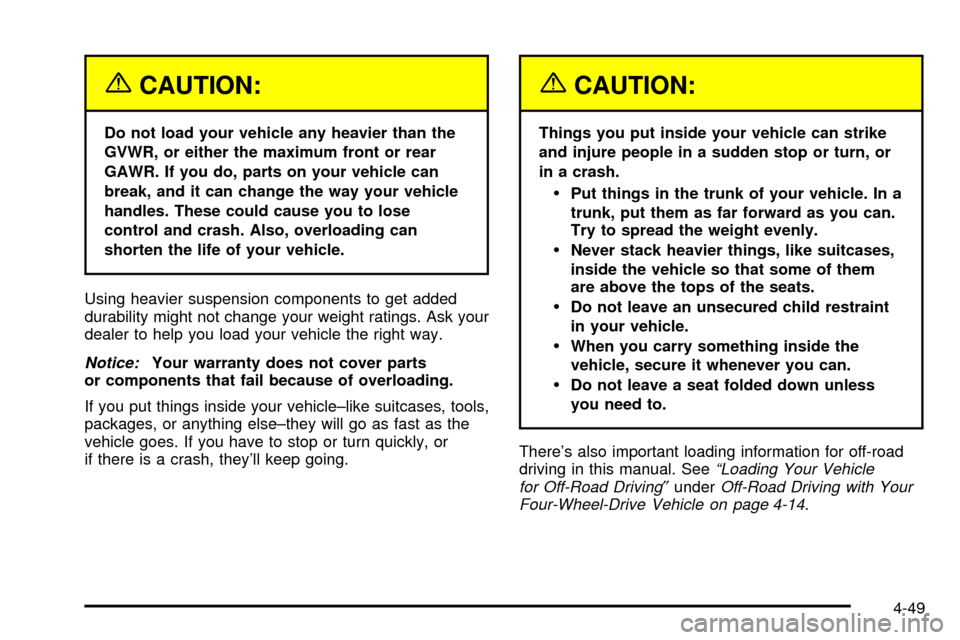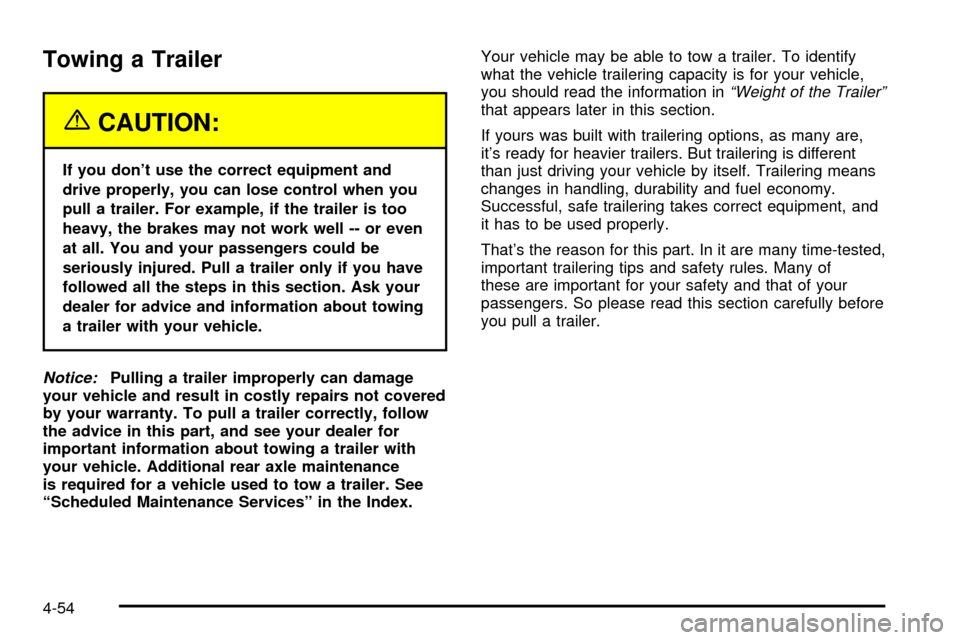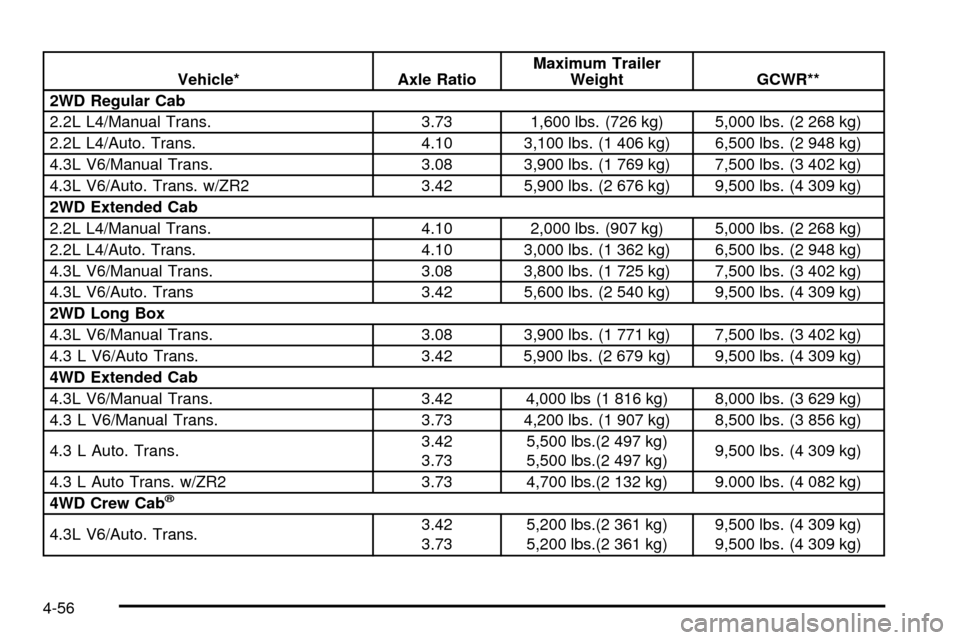CHEVROLET S10 2003 2.G Owners Manual
Manufacturer: CHEVROLET, Model Year: 2003, Model line: S10, Model: CHEVROLET S10 2003 2.GPages: 432, PDF Size: 2.82 MB
Page 251 of 432

{CAUTION:
Do not load your vehicle any heavier than the
GVWR, or either the maximum front or rear
GAWR. If you do, parts on your vehicle can
break, and it can change the way your vehicle
handles. These could cause you to lose
control and crash. Also, overloading can
shorten the life of your vehicle.
Using heavier suspension components to get added
durability might not change your weight ratings. Ask your
dealer to help you load your vehicle the right way.
Notice:Your warranty does not cover parts
or components that fail because of overloading.
If you put things inside your vehicle±like suitcases, tools,
packages, or anything else±they will go as fast as the
vehicle goes. If you have to stop or turn quickly, or
if there is a crash, they'll keep going.
{CAUTION:
Things you put inside your vehicle can strike
and injure people in a sudden stop or turn, or
in a crash.
·Put things in the trunk of your vehicle. In a
trunk, put them as far forward as you can.
Try to spread the weight evenly.
·Never stack heavier things, like suitcases,
inside the vehicle so that some of them
are above the tops of the seats.
·Do not leave an unsecured child restraint
in your vehicle.
·When you carry something inside the
vehicle, secure it whenever you can.
·Do not leave a seat folded down unless
you need to.
There's also important loading information for off-road
driving in this manual. See
ªLoading Your Vehicle
for Off-Road Driving²underOff-Road Driving with Your
Four-Wheel-Drive Vehicle on page 4-14.
4-49
Page 252 of 432

Payload
This is the maximum load capacity that your vehicle can
carry. Be sure to include the weight of the occupants
as part of your load. If you added any accessories
or equipment after your vehicle left the factory,
remember to subtract the weight of these things from
the payload. Your dealer can help you with this.
Remember not to exceed the Gross Axle Weight Rating
(GAWR) of the front or rear axle. See
Loading Your
Vehicle on page 4-48.
Two-Tiered Loading
By positioning four 2º x 6º wooden planks across the
width of the pickup box, you can create an upper
load platform. The planks must be inserted in the pickup
box depressions. The length of the planks must allow
for at least a 3/4 inch (2 cm) bearing surface on
each end of the plank.
When using this upper load platform, be sure the load is
securely tied down to prevent it from shifting. The
load's center of gravity should be positioned in a zone
over the rear axle.Any load that extends beyond the vehicle's taillamp
area must be properly marked according to local laws
and regulations.
Remember not to exceed the Gross Axle Weight Rating
(GAWR) of the rear axle. See
Loading Your Vehicle
on page 4-48.
Add-On Equipment
When you carry removable items, you may need to put
a limit on how many people you carry inside your
vehicle. Be sure to weigh your vehicle before you buy
and install the new equipment.
Notice:Your warranty does not cover parts or
components that fail because of overloading.
Remember not to exceed the Gross Axle Weight Rating
(GAWR) of the rear axle. See
Loading Your Vehicle
on page 4-48.
4-50
Page 253 of 432

Truck-Camper Loading Information
The Truck-Camper Loading label is located on the
passenger's door near the latch. It will tell you if your
vehicle can carry a slide-in camper, how much of a load
your vehicle can carry, and how to correctly spread
out your load. Also, it will help you match the right
slide-in camper to your vehicle.
When the truck is used to carry a slide-in camper, the
total cargo load of the truck consists of the
manufacturer's camper weight ®gure, the weight of
installed additional camper equipment not included in
the manufacturer's camper weight ®gure, the weight of
camper cargo, and the weight of passengers in the
camper. The total cargo load should not exceed
the truck's cargo weight rating and the camper's center
of gravity should fall within the truck's recommended
center of gravity zone when installed.
The Cargo Weight Rating (CWR) is the maximum
weight of the load your vehicle can carry. It doesn't
include the weight of the people inside. But, you
can ®gure about 150 lbs. (68 kg) for each seating
position. The total cargo load must not be more than
your vehicle's CWR.Refer to the Truck-Camper Loading Information Label
on the passenger's door for dimensions A and B as
shown in the following illustration.
Use the rear edge of the load ¯oor for measurement
purposes. The recommended location for the cargo
center of gravity for the Cargo Weight Rating (C) is the
point where the mass of a body is concentrated and, if
suspended at that point, would balance the front and rear.
4-51
Page 254 of 432

Here is an example of proper truck and camper match:
A. Camper Center of Gravity
B. Recommended Center of Gravity Location Zone
The camper's center of gravity should fall within the
center of gravity zone for your vehicle's cargo load.
Campers can only be installed in a long box pickup.
Check your Truck-Camper Loading Label on the
passenger's door to determine if your vehicle can carry
a slide-in camper.
You must weigh any accessories, trailer hitches or other
equipment you add to your vehicle. Then, subtract
this extra weight from the CWR. This extra weight may
shorten the center of gravity zone for your vehicle.
Your dealer can help you with this.If your slide-in camper and its load weigh less than the
CWR, the center of gravity zone for your vehicle
may be larger.
Your dealer can help you make a good vehicle-camper
match. He'll also help you determine your CWR.
Secure loose items to prevent weight shifts that could
affect the balance of your vehicle. When the truck
camper is loaded, drive to a scale and weigh on the
front and on the rear wheels separately to determine
axle loads. Individual axle loads should not exceed
either of the Gross Axle Weight Ratings (GAWR). The
total of the axle loads should not exceed the Gross
Vehicle weight Rating (GVWR). These ratings are given
on the vehicle certi®cation label that is located on the
rear of the passenger's door. If weight ratings are
exceeded, move or remove items to bring all weights
below the ratings.
If you want more information on curb weights, cargo
weights, cargo weight rating and the correct center
of gravity zone for your vehicle, your dealer can help
you. Just ask for a copy of ªConsumer Information,
Truck-Camper Loading.º
4-52
Page 255 of 432

Trailer Recommendations
You must subtract your hitch load from the CWR for
your vehicle. Weigh your vehicle with your trailer
attached, so that you won't go over the GVWR or the
GAWR.
You'll get the best performance if you spread out the
weight of your load the right way, and if you choose the
correct hitch and trailer brakes.
For more information, see
Towing a Trailer on page 4-54later in this section.
Pickup Conversion to Chassis Cab
General Motors is aware that some vehicle owners may
consider having the pickup box removed and a
commercial or recreational body installed. However, we
recommend that conversions of this type not be done
to pickups. Owners should be aware that, as
manufactured, there are differences between a chassis
cab and a pickup with the box removed which may
affect vehicle safety. For speci®c information on
this pickup, contact GM Customer Assistance. See
Customer Assistance Offices on page 7-4.
4-53
Page 256 of 432

Towing a Trailer
{CAUTION:
If you don't use the correct equipment and
drive properly, you can lose control when you
pull a trailer. For example, if the trailer is too
heavy, the brakes may not work well -- or even
at all. You and your passengers could be
seriously injured. Pull a trailer only if you have
followed all the steps in this section. Ask your
dealer for advice and information about towing
a trailer with your vehicle.
Notice:Pulling a trailer improperly can damage
your vehicle and result in costly repairs not covered
by your warranty. To pull a trailer correctly, follow
the advice in this part, and see your dealer for
important information about towing a trailer with
your vehicle. Additional rear axle maintenance
is required for a vehicle used to tow a trailer. See
ªScheduled Maintenance Servicesº in the Index.Your vehicle may be able to tow a trailer. To identify
what the vehicle trailering capacity is for your vehicle,
you should read the information in
ªWeight of the Trailerºthat appears later in this section.
If yours was built with trailering options, as many are,
it's ready for heavier trailers. But trailering is different
than just driving your vehicle by itself. Trailering means
changes in handling, durability and fuel economy.
Successful, safe trailering takes correct equipment, and
it has to be used properly.
That's the reason for this part. In it are many time-tested,
important trailering tips and safety rules. Many of
these are important for your safety and that of your
passengers. So please read this section carefully before
you pull a trailer.
4-54
Page 257 of 432

If You Do Decide To Pull A Trailer
If you do, here are some important points:
·There are many different laws, including speed limit
restrictions, having to do with trailering. Make sure
your rig will be legal, not only where you live
but also where you'll be driving. A good source for
this information can be state or provincial police.
·Consider using a sway control if your trailer will
weigh 3,500 lbs. (1 589 kg). You should always
use a sway control if your trailer will weigh
more than 3,500 lbs. (1 589 kg). You can ask a
hitch dealer about sway controls.
·Don't tow a trailer at all during the ®rst 500 miles
(800 km) your new vehicle is driven. Your engine,
axle or other parts could be damaged.
·Then, during the ®rst 500 miles (800 km) that you
tow a trailer, don't drive over 50 mph (80 km/h)
and don't make starts at full throttle. This helps your
engine and other parts of your vehicle wear in at
the heavier loads.
·You may want to shift the transmission to THIRD (3)
or, if necessary, a lower gear selection if the
transmission shifts too often (e.g., under heavy
loads and/or hilly conditions). If you have a manual
transmission and you are towing a trailer, it's
better not to use the highest gear.
Three important considerations have to do with weight:
·the weight of the trailer,
·the weight of the trailer tongue
·and the weight on your vehicle's tires.
Weight of the Trailer
How heavy can a trailer safely be?
It depends on how you plan to use your rig. For
example, speed, altitude, road grades, outside
temperature and how much your vehicle is used to pull
a trailer are all important. And, it can also depend
on any special equipment that you have on your vehicle.
The following chart shows how much your trailer can
weigh, based upon your vehicle model and options.
4-55
Page 258 of 432

Vehicle* Axle RatioMaximum Trailer
Weight GCWR**
2WD Regular Cab
2.2L L4/Manual Trans. 3.73 1,600 lbs. (726 kg) 5,000 lbs. (2 268 kg)
2.2L L4/Auto. Trans. 4.10 3,100 lbs. (1 406 kg) 6,500 lbs. (2 948 kg)
4.3L V6/Manual Trans. 3.08 3,900 lbs. (1 769 kg) 7,500 lbs. (3 402 kg)
4.3L V6/Auto. Trans. w/ZR2 3.42 5,900 lbs. (2 676 kg) 9,500 lbs. (4 309 kg)
2WD Extended Cab
2.2L L4/Manual Trans. 4.10 2,000 lbs. (907 kg) 5,000 lbs. (2 268 kg)
2.2L L4/Auto. Trans. 4.10 3,000 lbs. (1 362 kg) 6,500 lbs. (2 948 kg)
4.3L V6/Manual Trans. 3.08 3,800 lbs. (1 725 kg) 7,500 lbs. (3 402 kg)
4.3L V6/Auto. Trans 3.42 5,600 lbs. (2 540 kg) 9,500 lbs. (4 309 kg)
2WD Long Box
4.3L V6/Manual Trans. 3.08 3,900 lbs. (1 771 kg) 7,500 lbs. (3 402 kg)
4.3 L V6/Auto Trans. 3.42 5,900 lbs. (2 679 kg) 9,500 lbs. (4 309 kg)
4WD Extended Cab
4.3L V6/Manual Trans. 3.42 4,000 lbs (1 816 kg) 8,000 lbs. (3 629 kg)
4.3 L V6/Manual Trans. 3.73 4,200 lbs. (1 907 kg) 8,500 lbs. (3 856 kg)
4.3 L Auto. Trans.3.42
3.735,500 lbs.(2 497 kg)
5,500 lbs.(2 497 kg)9,500 lbs. (4 309 kg)
4.3 L Auto Trans. w/ZR2 3.73 4,700 lbs.(2 132 kg) 9.000 lbs. (4 082 kg)
4WD Crew Cab
ž
4.3L V6/Auto. Trans.3.42
3.735,200 lbs.(2 361 kg)
5,200 lbs.(2 361 kg)9,500 lbs. (4 309 kg)
9,500 lbs. (4 309 kg)
4-56
Page 259 of 432

* If your vehicle is equipped with RPO V4A (XtremeŸ
Sport Appearance Package), your vehicle was
neither intended nor designed to tow a trailer. For more
information on RPO codes, see
Service Parts
Identi®cation Label on page 5-92.
Maximum trailer weight is calculated assuming only the
driver is in the tow vehicle and it has all the required
trailering equipment. The weight of additional optional
equipment, passengers and cargo in the tow vehicle
must be subtracted from the maximum trailer weight.
The weight of the trailer tongue also affects trailering
capacity. See²
Weight of the Trailer Tongue²next.**The Gross Combination Weight Rating (GCWR) is the
total allowable weight of the completely loaded vehicle
and trailer including any passengers, cargo, equipment
and conversions. The GCWR for your vehicle should
not be exceeded.
You can ask your dealer for our trailering information or
advice, or you can write us at the address listed in your
Warranty and Owner Assistance Information Booklet.
In Canada, write to:
General Motors of Canada Limited
Customer Communication Centre, 163-005
1908 Colonel Sam Drive
Oshawa,, Ontario L1H 8P7
4-57
Page 260 of 432

Weight of the Trailer Tongue
The tongue load (A) of any trailer is an important weight
to measure because it affects the total or gross weight
of your vehicle. The Gross Vehicle Weight (GVW)
includes the curb weight of the vehicle, any cargo you
may carry in it, and the people who will be riding in
the vehicle. And if you will tow a trailer, you must add
the tongue load to the GVW because your vehicle will be
carrying that weight, too. See
Loading Your Vehicle
on page 4-48for more information about your vehicle's
maximum load capacity.If you're using a weight-carrying or a weight-distributing
hitch, the trailer tongue weight (A) should be 10 percent
to 15 percent of the total loaded trailer weight (B).
Do not exceed the maximum allowable tongue weight
for your vehicle.
After you've loaded your trailer, weigh the trailer and
then the tongue, separately, to see if the weights
are proper. If they aren't, you may be able to get them
right simply by moving some items around in the
trailer.
Total Weight on Your Vehicle's Tires
Be sure your vehicle's tires are in¯ated to the upper limit
for cold tires. You'll ®nd these numbers on the
Certi®cation label at the rear edge of the driver's door
above the door latch, or see
Loading Your Vehicle
on page 4-48. Then be sure you don't go over the GVW
limit for your vehicle, including the weight of the trailer
tongue.
4-58